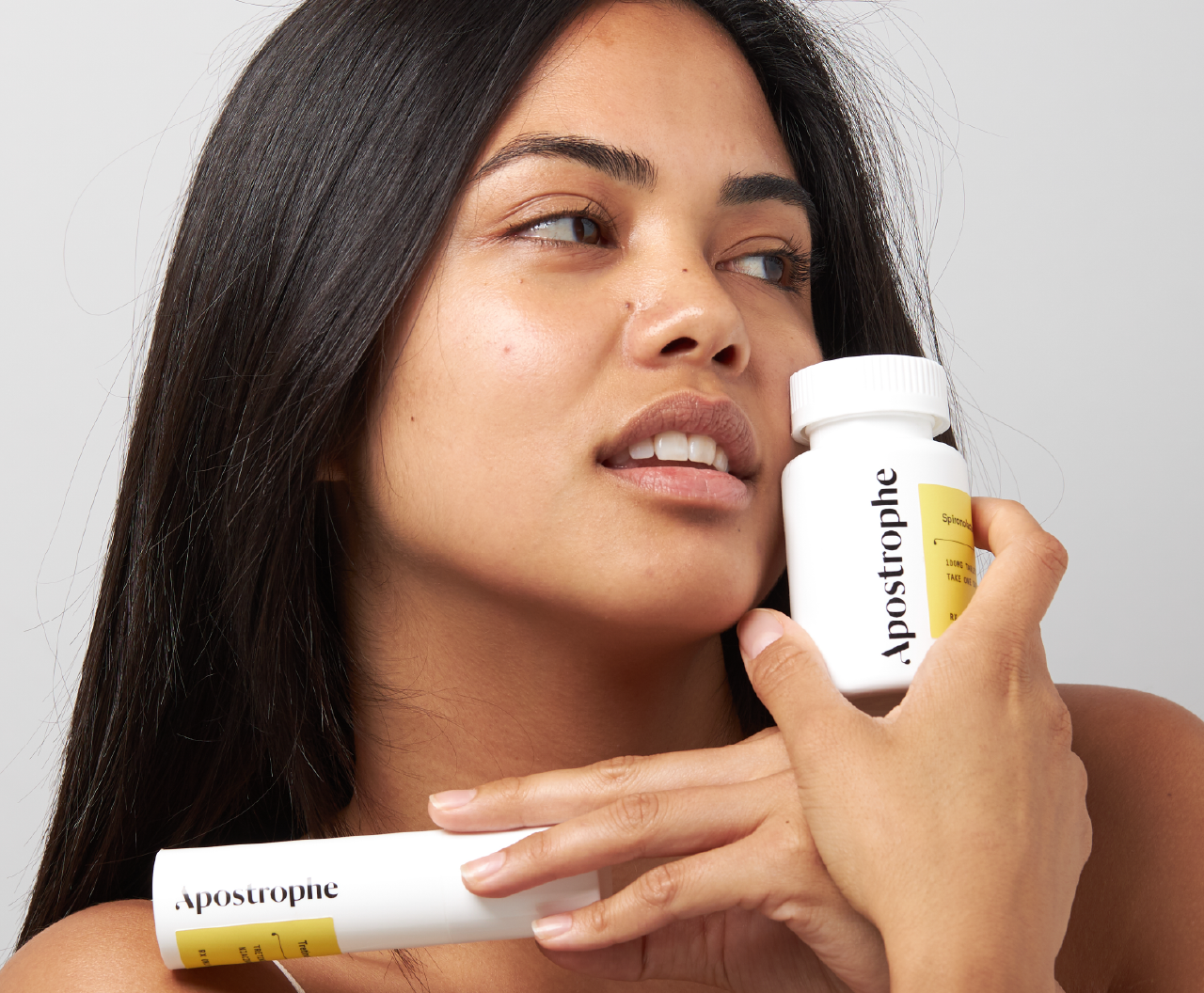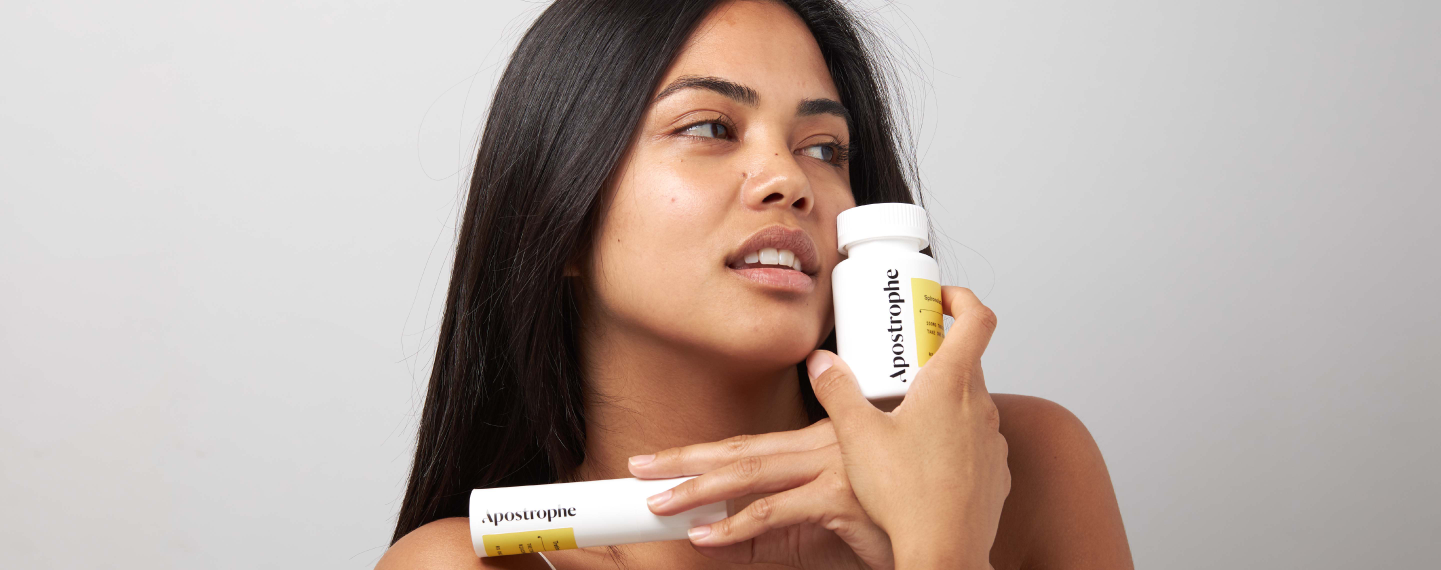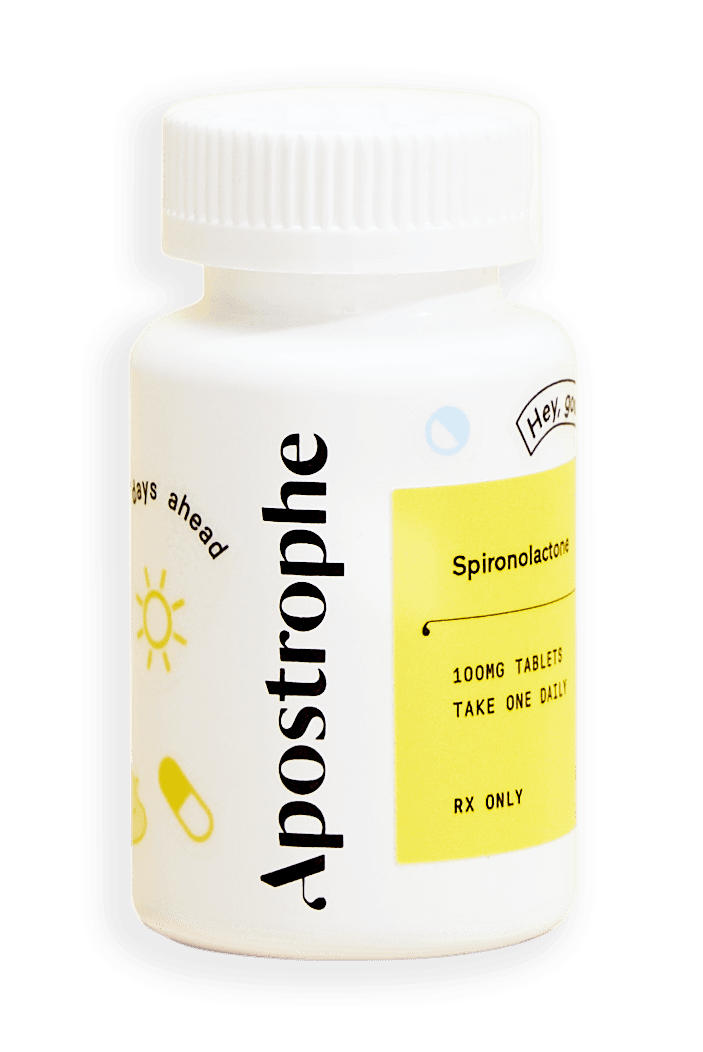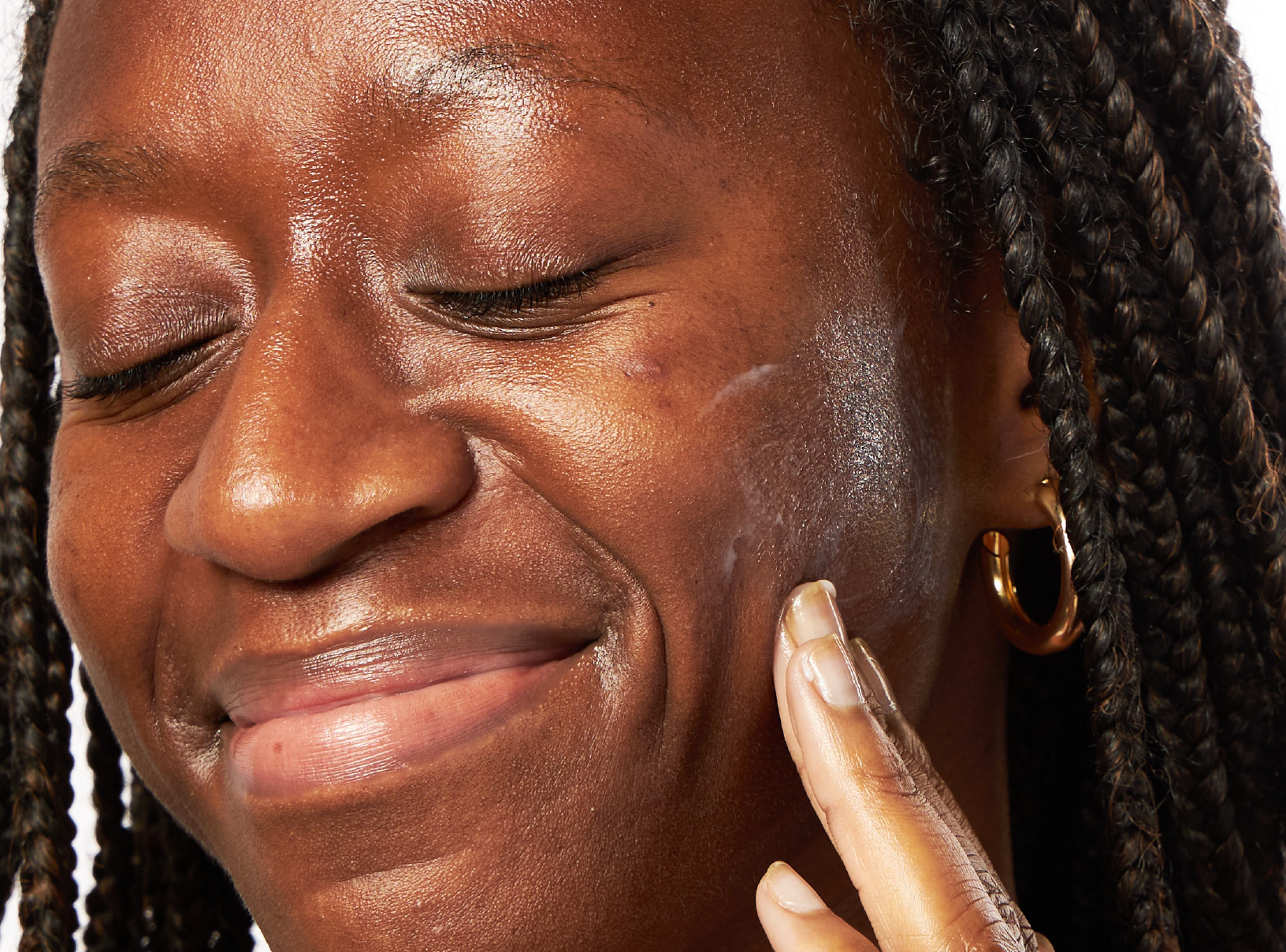Education
Prescription Acne Medication | Apostrophe


SHARE
Education
Prescription Acne Medication | Apostrophe
Medically reviewed by Aimee Paik, MD
Written by Apostrophe Team
Last updated 11/1/2024
We’ve all woken up with a pimple or two, but when breakouts don't stop, it might be time to visit the dermatologist. Acne can be confidence-crushing and painful. Luckily, you’re not limited to the cleansers and face masks that line the aisles of your local drug store.
When you visit an online dermatologist or talk to one in person, you’ll unlock a whole new world of prescription acne medication. If you’re ready to take your personalized skin care routine to the next level, keep reading for a full breakdown of all your prescription acne medication options, from topical acne treatment to prescription medication pills.
Topical Prescription Acne Medication
Dermatologists treat all sorts of skin conditions. In fact, they can identify and treat over 3,000 different conditions, but acne is the most common reason patients make the trip to the dermatologist.
If you have mild to moderate acne, you will probably first try over-the-counter options; however, if those don’t work, there are plenty of topical prescription acne medications that a dermatologist can prescribe. We’ll look at five all-star topical prescriptions:
Azelaic Acid
Topical Retinoid
Topical Spironolactone
Topical Antibiotics
Topical Combination Medications
Azelaic Acid
First up in azelaic acid. Let’s learn the ABC’s of this amazing acid:
What is it? Azelaic acid is a naturally occurring acid that is comedolytic (unclogs pores), antimicrobial, and anti-inflammatory.
How does it work? Azelaic acid can fight bacteria and halt the processes that cause inflammation in your skin.
Who is it for? Azelaic acid is great for acne sufferers, especially those experiencing postinflammatory hyperpigmentation.
How do you use it? We recommend applying a thin layer of azelaic acid all over the skin one to two times per day.
What are the side effects? While azelaic acid is generally well tolerated, it may cause initial sensitivity or irritation in the form of redness or burning.
Topical Retinoid
Next up are the always reliable retinoids:
What is it? Retinoids are derivatives of vitamin-A with comedolytic (unclogging) and anti-inflammatory properties. There are three prescription retinoids: tretinoin, adapalene, and tazarotene.
How does it work? These retinoids bind to your cells and cause the skin to increase its turnover rate, resulting in a reduction in clogged pores, inflammation, pigmentation, and collagen loss and even stimulating new collagen.
Who is it for? They are the first line of treatment for mild to moderate acne, especially comedonal acne, but they are appropriate for all acne severities. However, they are not safe for pregnant women.
How do you use it? You should apply a thin layer in the evening. Avoid using tretinoin in the same routine as benzoyl peroxide.
What are the side effects? Retinoids can cause dryness, peeling, redness, and irritation. These side effects can decrease if you use the retinoid less frequently, apply less, or apply a moisturizer first.
Topical Spironolactone
We couldn’t discuss topical treatment without mentioning spironolactone:
What is it? Spironolactone is an androgen-blocker, meaning that it decreases the male sex hormone androgen.
How does it work? By blocking androgens, spironolactone reduces both the size and activity of oil glands.
Who is it for? Topical spironolactone is appropriate for people of all genders suffering from acne.
How do you use it? Apply a thin layer across the skin each evening.
What are the side effects? Unlike oral spironolactone, topical spironolactone is not associated with any systemic side effects because it is only applied to the skin rather than affecting the whole body.
Topical Antibiotics
We can’t forget to mention our antibiotics:
What is it? They are a topical version of the same antibiotics such as clindamycin that you might take when you’re sick.
How does it work? They work their magic inside the hair follicle and have both antibacterial and anti-inflammatory properties.
Who is it for? These are safe for almost everyone; however, because of antibiotic resistance, they aren’t usually prescribed on their own. Rather, doctors often prescribe them in combination with benzoyl peroxide.
How do you use it? Apply a thin layer one to two times per day.
What are the side effects? These topical treatments are well tolerated with very few side effects.
Topical Combination Medications
We couldn’t move onto oral prescriptions without first discussing combination medications:
What is it? Combination medications include multiple topical treatments such as a retinoid and benzoyl peroxide or an antibiotic and benzoyl peroxide.
How does it work? These treatments have the same mechanism of action as their separate components, but by combining them, their efficacy is increased.
Who is it for? These combination medications benefit by treating your acne and achieving clear skin with time under the guidance of a dermatologist.
How do you use it? Generally, you use these combination medications the same as you would use their separate components.
What are the side effects? The possible side effects are the same as the included topical medication; however, certain side effects can be enhanced, for example, increased dryness if both components have that side effect.
Oral Prescription Acne Medication
Some patients with mild to moderate acne don’t see success with just topical treatments. More frequently, patients with moderate to severe inflammatory acne may need a little extra help to get their acne under control.
In these cases, dermatologists prefer to prescribe the best oral medication for acne in combination with topical treatments. So without further ado, let’s meet our four gold-medal acne-fighting pills:
Oral Antibiotics
Oral Spironolactones
Oral Contraceptives
Isotretinoin
Oral Antibiotic
The same antibiotics but in the form of a pill can also be used for acne:
What is it? These are antibiotics such as doxycycline, minocycline, cephalexin, and more. The tetracycline class, which includes doxycycline and minocycline, is the most common.
How does it work? Antibiotics halt the inflammation process and reduce acne.
Who is it for? Oral antibiotics are best for patients with moderate to severe inflammatory acne or acne that has not been well controlled by topical medications. Certain antibiotics, including the tetracycline class, are not safe for pregnant patients.
How do you use it? You will take the antibiotic each day for a period of several months.
What are the side effects? There can be a range of side effects. Minocycline and doxycycline can cause gastrointestinal disturbances, photosensitivity, pediatric tooth discoloration, dizziness, and more.
Oral Spironolactone
Another familiar face, spironolactone is also available in an oral medication form:
What is it? Spironolactone is an antiandrogen medication that decreases the production of androgens in your body. While topical spironolactone only affects the skin, oral spironolactone acts on the entire body.
How does it work? Spironolactone decreases the size and activity of oil glands by blocking androgens in your body.
Who is it for? Spironolactone is a good choice for women suffering from hormonal acne. It’s not safe for men or pregnant women because of how it affects hormones throughout the body. It’s better for women with moderate to severe acne that is not responding to topical treatments alone.
How do you use it? It is a pill that you will take daily.
What are the side effects? The most common side effects include diuresis, menstrual irregularities, breast tenderness and enlargement, fatigue, headache, and dizziness.
Oral Contraceptives
We can’t forget about our contraceptives:
What is it? Known colloquially as birth control, oral contraceptives contain hormones that prevent pregnancy and can also treat acne.
How does it work? Oral contraceptives that contain estrogen decrease the amount of free testosterone in the body, which helps to decrease acne.
Who is it for? Oral contraceptives are a second-line acne treatment for women, regardless of the cause of their acne, although it may be especially helpful for women with hormonal acne.
How do you use it? These pills are taken once per day.
What are the side effects? Possible side effects include bloating, decreased libido, nausea, and vomiting. More serious but rare side effects include cardiovascular problems or stroke.
Isotretinoin
Last but certainly not least, the true heavyweight acne-crushing champion is isotretinoin:
What is it? Like topical retinoids, isotretinoin is a derivative of Vitamin A; however, it is an oral version.
How does it work? Isotretinoin targets all of the causes of acne and works by decreasing oil production, c. acne bacteria, and inflammation.
Who is it for? Isotretinoin is prescribed for patients with severe nodulocystic acne or acne that does not respond well to other oral and topical treatments. It is not safe for pregnant women.
How do you use it? Isotretinoin is taken every day for a period of between 16 and 30 weeks.
What are the side effects? Common side effects include dryness in the eyes, nose, and lips as well as dermatitis. More serious side effects are possible, so patients are monitored very closely.
Prescription Acne Medication Straight to Your Doorstep with Apostrophe
Whether you deal with the occasional pimple or constant breakouts, there is help out there. With guidance from a dermatologist, you can finally conquer your acne and let your inner radiance shine through.
Apostrophe can be part of your acne-fighting team by helping you get access to expert treatment from board-certified dermatologists and healthcare providers to start your journey to healthy skin.
Sources:
American Academy of Dermatology Association. What is a dermatologist?
https://www.aad.org/public/fad/what-is-a-derm
Journal of Drugs in Dermatology. Inflammatory Acne Treatment: Review of Current and New
Topical Therapeutic Options. https://jddonline.com/articles/dermatology/S1545961616S0011X
National Center for Biotechnology Information. A review of diagnosis and treatment of acne in adult female patients. https://www.ncbi.nlm.nih.gov/pmc/articles/PMC5986265/
Journal of Drugs in Dermatology. Azelaic Acid: Evidence-based Update on Mechanism of Action and Clinical Application. https://jddonline.com/articles/dermatology/S1545961615P0964X
Hilary E. Baldwin, et al. 40 Years of Topical Tretinoin Use in Review.
https://jddonline.com/articles/dermatology/S1545961613P0638X/4
Nicola I. Espinosa and Philip R. Cohen. Acne Vulgaris: A Patient and Physician’s Experience.
https://link.springer.com/article/10.1007/s13555-019-00335-0
Apostrophe. What is Topical Spironolactone?
https://www.apostrophe.com/medications/topical-spironolactone/
Wiley Online Library. Efficacy and safety of topical spironolactone 5% cream in the treatment of acne: A pilot study. https://onlinelibrary.wiley.com/doi/full/10.1002/hsr2.317
Science Direct. Guidelines of care for the management of acne vulgaris.
https://www.sciencedirect.com/science/article/pii/S0190962215026146
National Center for Biotechnology Information. Management of acne.
https://www.ncbi.nlm.nih.gov/pmc/articles/PMC3080563/
National Center for Biotechnology Information. Oral Doxycycline in the Management of Acne Vulgaris: Current Perspectives on Clinical Use and Recent Findings with a New Double-scored Small Tablet Formulation. https://www.ncbi.nlm.nih.gov/pmc/articles/PMC4445892/
Oxford University Press. Minocycline as A Substitute for Doxycycline in Targeted Scenarios: A Systematic Review. https://academic.oup.com/ofid/article/2/4/ofv178/2460641
Shop this post

Azelaic acid + niacinamide formula

Clindamycin

Oral doxycycline

Oral minocycline

Oral Spironolactone

Tazarotene + niacinamide formula

Topical Spironolactone

Tretinoin
Like what you just read? Sign up for our email list to get the scoop on skincare science delivered straight to your inbox.

Deep Dives
A dermatologist shares his thoughts on the recent studies about benzoyl peroxide and benzene.
Read More
Education
What is milia?
What is milia? Today, we’re jumping into one type of bump that you may have heard about most commonly in infants — milia.
Read More
Education
Best moisturizer for acne-prone skin
If you have combination acne-prone skin, figuring out which moisturizer is best for your skin might be tough. In this guide, we break down the best moisturizer for combination, acne-prone skin.
Read More
